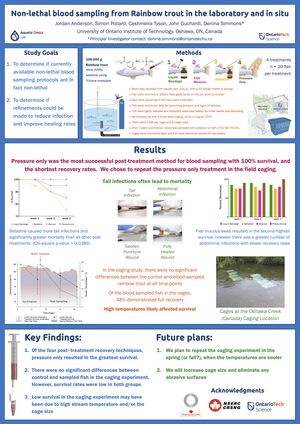Difference between revisions of "Blood sampling of rainbow trout"
m (Added links to websites) |
Werenskjold (talk | contribs) |
||
| Line 1: | Line 1: | ||
| − | Poster Title: '''''Non-lethal blood sampling from Rainbow trout in the laboratory and in situ''''' | + | Poster Title: '''''Non-lethal blood sampling from Rainbow trout in the laboratory and in situ''''' |
Co-authors: J. Anderson, S. Pollard, C.D. Tyson, J. Guchardi, D.B.D. Simmons | Co-authors: J. Anderson, S. Pollard, C.D. Tyson, J. Guchardi, D.B.D. Simmons | ||
Revision as of 22:14, 31 January 2021
Poster Title: Non-lethal blood sampling from Rainbow trout in the laboratory and in situ
Co-authors: J. Anderson, S. Pollard, C.D. Tyson, J. Guchardi, D.B.D. Simmons
Aquatic Omics Lab, Ontario Tech University, Oshawa, ON, Canada
The use of humane methods in animal research is an internationally recognized priority, but few Environmental Effects Monitoring programs use non-lethal methods with fish, and the ones that do are normally limited to behaviour, morphology and reproduction.
The goal of the study shown in this poster was to determine the impacts and survival of larger bodied fish after sampling small volumes of blood for the purpose of using non-lethal methods in Environment Effects Monitoring.
Overall, we observed 90% survival among all treatments; the most effective approach was the pressure-only (100% survival), while the post-treatment with the largest impact on fish survival was the use of betadine (75% survival).
We plan to repeat this test in the natural environment, and will post more information later.
The poster may be downloaded as a pdf file here.
